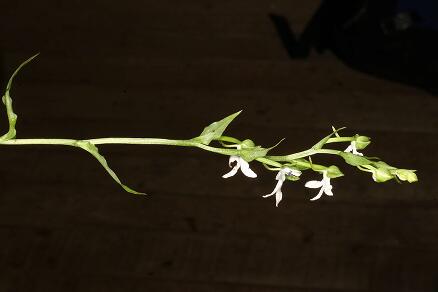Orchidaceae
Habenaria

Kingdom: Plantae Rank: Genus Parent: Orchidaceae Status: Valid
Morphological Description
Diagnosis:
Plants of Habenaria have unbranched stems with persistent leaves along the stem – the leaves lack an abscission layer and wither on the plant. The only similar plants in the flora are those of Erythrodes (s.l.) which differ by having stems which root at the nodes. The flowers of Habenaria typically have 3-lobed lips, 2-lobed petals, and a conspicuous slender spur.
1 Flowers 1-3; spur more than 4 cm long. ........ H. trifida
1’ Flowers more than 5; spur less than 3.5 cm long. ....... 2
2(1’) Lateral lip lobes, if present, wider than the midlobe;
flowers tricolored. ....................... H. corydophora
2’ Lateral lip lobes, if present, equal in width or narrower
than the midlobe. ...................................... 3
3(2’) Flowers pure white; basal leaf sheaths with conspicuous
nearly black markings. ..................... H. monorrhiza
3’ Flowers various combinations of green, white, and yellow;
leaf sheaths unmarked. ................................. 4
4(3’) Petals and lip unlobed. ...................... H. ligulata
4’ Petals and lip lobed. .................................. 5
5(4’) Spur less than ¼ the length of the lip midlobe. ..........
........................................ H. parvicalcarata
5’ Spur subequal to or longer than the lip midlobe. ....... 6
6(5’) Upper petal lobe minutely 3-lobulate at the +/- truncate
apex. ....................................... H. dentifera
6’ Petal apices not lobulate. ............................. 7
7(6’) Petal lobes subequal in width. ......................... 8
7’ Petal lobes unequal, the upper lobe significantly wider
than the lower lobe. ................................... 9
8(7) Lip midlobe shorter and wider than the lateral lobes. ....
.......................................... H. guentheriana
8’ Lip lobes subsimilar, subequal. ............. H. paivaeana
9(7’) Petals obscurely lobed at the base. ......... H. parvidens
9’ Petals obviously lobed, mitten-shaped. ................ 10
10(9’) Flowers 4-7; the lateral sepals 2 mm wide. . H. pumiloides
10’ Flowers more than 10; the lateral sepals 4 mm wide. ......
............................................ H. uncatiloba
Vegetative Morphology
Habit: Terrestrials arising from paired tubers, rarely epiphytic.
Main axis: Stems erect, unbranched.
Leaves: Leaves one to numerous, basal, scattered along the stem, or subwhorled, membranous, without an abscission layer.
Reproductive Morphology
Inflorescence: Inflorescences terminal racemes, rarely scapes, loosely-flowered to densely-flowered and cylindric, the floral bracts minute to conspicuous, sometimes foliaceous.
Flowers: Flowers minute and inconspicuous to large and showy, mostly green, yellow or white. Sepals and petals free, the dorsal sepal and petals often forming a hood, the petals often lobulate. Lip unlobed to more commonly three-lobed, spurred, the lobes often further subdivided, often linear, the spurs short to elongate, cylindric to club-shaped, often incurved. Column complex, with two stigmas often on elongate processes and two separate anther sacs, the rostellum usually conspicuous; pollinia 2, each on an elongate caudicle with a minute viscidium.